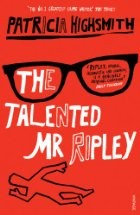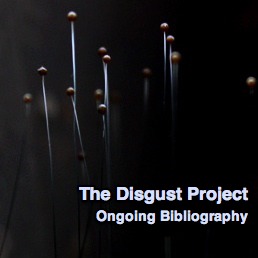
You know what sucks? Reading slumps. All the while I've not been blogging over the past few weeks (with the exception of the sex scene entry, which, THANKS, by the way, for all those amazing comments), I bet that some of you were imagining that was due to writer's block or a busy social life or some such thing but I tell you now it's because I've barely picked up a book in all that time. I just can't seem to settle to anything. Whenever this happens to me, which is luckily not often, it makes me twitchy and irritable and generally unpleasant, but there's no use forcing the issue: it will come to an end eventually.
In any case, I did, finally, in dribs and drabs, finish Patricia Highsmith's classic psychological thriller The Talented Mr. Ripley, so I can at least post about that. The Ripley novels, I think, are examples of those books whose basic premises most people either know or think they know, to wit: charismatic psychopath social climber kills a wealthy friend of his and steals friend's identity. Yet I was surprised at the degree to which Tom Ripley (in this first book, at least) is not so much the winning, charismatic charmer he may later become—not yet quite so talented, perhaps—but more of a sullen, insecure kid one step ahead of the law, with the most unnervingly and convincingly unstable personalities I've ever run across in fiction. Ripley does not come across, to my surprise, as constantly on top of things, or particularly premeditating, and although he does have a fairly good ability to win people over, at least temporarily, it takes a gargantuan effort for him to overcome his distaste for "normal" behavior and for most of the people surrounding him, in order to do so. Nor can he rely on his own mental processes or moods being at all predictable. In this early scene, for example, Tom is being wined and dined by his "friend"'s parents in their Manhattan apartment, and has a sudden near-break with his own sense of identity:
When he had said to Mrs. Greenleaf just now, I'll do everything I can ... Well, he meant it. He wasn't trying to fool anybody.
He felt himself beginning to sweat, and he tried to relax. What was he so worried about? He'd felt so well tonight! When he had said that about Aunt Dottie—
Tom straightened, glancing at the door, but the door had not opened. That had been the only time tonight when he had felt uncomfortable, unreal, the way he might have felt if he had been lying, yet it had been practically the only thing he had said that was true: My parents died when I was very small. I was raised by my aunt in Boston.
What Highsmith does so well, I think, is to portray the difficulty Tom has in distinguishing between real and imaginary, fact and fiction. Logically, he knows that he ought to associate his true statements ("My parents died when I was very small") with a feeling of groundedness, of the reality of his own person-hood—and logically, he knows that lying ought to make him feel less real, more uncomfortable. He runs into two problems: one, that his sense of reality is tenuous at best, not particularly tethered one way or another to the truthfulness of his statements or the genuineness of his current persona. He is prone to bursts of manic confidence alternating with near-baseless panic attacks, and although the reader can see Tom attempting to correlate these moods with external causes ("He'd felt so well tonight!") and his own motivations ("He wasn't tying to fool anybody"), the truth of Highsmith's portrayal seems to me to reflect the fluctuations of severely unbalanced brain chemistry more than logical cause and effect. Tom's psychopathic blankness of personality lend him his frightening ability to inhabit whatever persona he chooses, but Highsmith also lets us glimpse how that lack of mooring within his own head is profoundly frightening (and exhilarating) for Tom himself.
A state which only worsens, of course, since Tom's second problem is that as the novel progresses he spends so much time crafting convincing lies, truly inhabiting his roles and becoming the characters he pretends to be—"Tom Ripley" just one among many—that there really is no longer much difference in his mind between the factually true and false, or between the imagined and actual. In one vertiginous scene, Tom imagines that he has killed someone who is actually still alive, and reels with the inability to reverse the action, not wanting to have taken that irrevocable step into the state of murderer. The irony being, of course, that while the object of his imaginary crime still lives, the victims of his two real murders do not: and Tom is not hyperventilating over them.
I definitely want to mention in this post the uneasy place this novel must hold in the emerging canon of queer literature. Citing The Talented Mr. Ripley as "LGBT Lit" might be similar to arguing a point about abortion using Hemingway's short story "Hills Like White Elephants": it's a masterful piece of work that has the issue as a prominent theme, yet offers no particular conclusions on the subject. Though Highsmith slept with both men and women ("relationships" might be too soft a word), and though Tom is a semi-closeted gay man whose issues around his sexuality play into his eventual crimes, The Talented Mr. Ripley comes across as neither a "pro-gay" or "anti-gay" novel. In fact, it seems perfectly possible to me to argue any of three positions, based on the text:
- Tom's homosexuality is another facet of the mental illness or "wrongness" that leads to him becoming a murderer.
- The social pressures that force Tom to remain closeted and ashamed gradually destroy his sense of self and lead him into murder.
- Tom is a born psychopath who also happens to be gay. The two elements of his personality are unconnected.
Perhaps it goes without saying that I prefer the third analysis. However, I do honestly think one could cite evidence for any of the three, and it's hard to dismiss whispers of any of any of them completely. Highsmith is many things, but she is neither didactic nor reassuring. I can't help but respect her more because of it.
Notes on Disgust
(for more information on the disgust project, see here)
The Talented Mr. Ripley is a great choice for the disgust project, because disgust features in the novel just enough to be interesting, but not so much that it overwhelms the narrative. Most often, Tom's disgust is used to mark out his conflicted sexual feelings, especially where Marge, the friend and would-be girlfriend of Dickie Greenleaf, is concerned. Tom only admits to himself in flashes his desire to kiss, be close to, and later kill and replace Dickie, but his possessiveness and unacknowledged homosexuality make their way into the open via his extreme aversion to anything relating to Marge, from her clothes hanging to dry on the lines to her very presence on outings with Dickie. When Tom sees the two of them kissing, he feels nauseated:
Now Marge's face was tipped straight up to Dickie's, as if she were fairly lost in ecstasy, and what disgusted Tom was that he knew Dickie didn't mean it, that Dickie was only using this cheap obvious, easy way to hold on to her friendship. What disgusted him was the big bulge of her behind in the peasant skirt below Dickie's arm that circled her waist. And Dickie—! Tom really wouldn't have believed it possible of Dickie!
Tom turned away and ran down the steps, wanting to scream.
He then runs back to the house he's sharing with Dickie, puts on Dickie's clothes, and pretends to break up with Marge in Dickie's voice—all of which foreshadows his eventual crimes toward Dickie, and adds another level of significance to Tom's disgust at seeing Marge's bras on the clothes line. Later on, Tom's disgust becomes ever more closely linked with his murders (he feels disgust on seeing the body of his second victim lying on the floor, and on recalling that person's actions leading up to the crime) and his contemplated murders (while thinking about committing the murder that never quite happens, he is disgusted by incidentals: people at a party, and some algae growing by his doorstep).
In none of these cases is the disgust directed inwards, towards Tom Ripley and the acts he has committed. In none of them does Tom feel moral disgust, only physical or circumstantial repulsion (the closest he gets to righteous disgust is late in the book, when he is being hounded by the Italian press and claims to be "irritated and disgusted" with them). Significantly, though, not only does Tom fail to apply any standards of disgust to himself, but the feeling usually indicates the bubbling up of feelings or memories he is trying to repress. Although Tom himself seems not to make the connection, disgust here seems to be a sign of cognitive dissonance which the rest of Tom's wildly swinging moods don't necessarily acknowledge. It often makes him seem less human—as when he's practically vomiting over a kiss between Marge and Dickie, or when he feels repulsed rather than horrified while gazing at the body of his victim—but in a way, the disgust is one of the most humane aspects of his reactions, one of the lingering remnants of whatever morality he may once have possessed.


